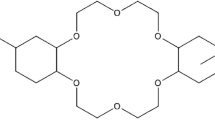Abstract
We present a chromatography chemistry for purifying protactinium from uranium metal alloys containing weight-percent concentrations of niobium. Niobium is precipitated in 9 M HCl without the co-precipitation of Pa as demonstrated by gamma-ray spectrometry. Protactinium is further purified using Bio-Rad™ anion resin AG® 1-X8 and 9 M HCl + 0.0128 M HF. A Pa/Nb separation factor of 85,000 and a 90% Pa recovery is demonstrated, which is amenable to 231Pa concentration determination by isotope dilution and 231Pa/235U model age calculation for nuclear forensics.




Similar content being viewed by others
References
Kristo MJ, Gaffney AM, Marks N, Knight K, Cassata WS, Hutcheon ID (2016) Nuclear forensic science: analysis of nuclear material out of regulatory control. Ann Rev Earth Planetary Sciences 44:555
Varga Z, Mayer K, Bonamici C, Hubert A, Hutcheon I, Kinman W, Kristo M, Pointurier F, Spencer K, Stanley F et al (2015) Validation of reference materials for uranium radiochronometry in the frame of nuclear forensic investigations. Appl Radiat Isot 102:81–86
Higginson M, Gilligan C, Taylor F, Knight D, Kaye P, Shaw T, Thompson P (2018) Development of rapid methodologies for uranium age dating. J Radioanal Nucl Chem 318(1):157–164
Mendes M, Aupiais J, Jutier C, Pointurier F (2013) Determination of weight distribution ratios of Pa (V) and Np (V) with some extraction chromatography resins and the AG1-X8 resin. Anal Chim Acta 780:110–116
Kayzar TM, Williams RW (2016) Developing 226Ra and 227Ac age-dating techniques for nuclear forensics to gain insight from concordant and non-concordant radiochronometers. J Radioanal Nucl Chem 307(3):2061–2068
Laue C, Gates-Anderson D, Fitch T (2004) Dissolution of metallic uranium and its alloys. J Radioanal Nucl Chem 261(3):709–717
Aizenshtein M, Brosh E, Ungarish Z, Levi S, Tubul M, Fadel D, Greenberg E, Hayun S (2022) High entropy uranium-based alloys: Thermodynamics, characterization and mechanical properties. J Nucl Mater 558:153378
Zubelewicz A, Addessio F, Cady C (2006) A constitutive model for a uranium-niobium alloy. J Appl Phys 100(1):013523
Bojinov M, Karastoyanov V, Kinnunen P, Saario T (2010) Influence of water chemistry on the corrosion mechanism of a zirconium–niobium alloy in simulated light water reactor coolant conditions. Corros Sci 52(1):54–67
Polovov I (2015) Interaction of niobium-containing chloride melts with niobium metal. In: 2015-Sustainable industrial processing summit, (vol. 7, pp 231–232). Flogen Star Outreach.
Münker C, Weyer S, Scherer E, Mezger K (2001) Separation of high field strength elements (Nb, Ta, Zr, Hf) and Lu from rock samples for MC-ICPMS measurements. Geochem Geophys Geosyst. https://doi.org/10.1029/2001GC000183
Remenec B, Dulanska S, Gardonova V, Matel L (2013) Determination of 94Nb in radioactive waste using ion exchange chromatography. J Radioanal Nucl Chem 295(2):907–910
Wilson RE, De Sio S, Vallet V (2018) Protactinium and the intersection of actinide and transition metal chemistry. Nat Commun 9(1):1–9
Kraus KA, Moore GE (1951) Anion exchange studies. Iii. Protactinium in some HCl—HF mixtures: separation of niobium, tantalum and protactinium. Part I. J. Am Chem Soc 73(6):13–15
Usman K, MacMahon T (2000) Determination of the half-life of 233Pa. Appl Radiat Isot 52(3):585–589
Espartero A, Suárez J, Rodrıguez M (1998) Determination of 93Nb and 94Nb in medium and low-level radioactive wastes. Appl Radiat Isot 49(9–11):1277–1282
Eppich GR, Williams RW, Gaffney AM, Schorzman KC (2013) 235U–231Pa age dating of uranium materials for nuclear forensic investigations. J Anal At Spectrom 28(5):666–674
Du M, Hylton T (2019) Chemical processes for recovery of high purity 234U from aged 238PU (No. ORNL/TM-2019/1343). Oak Ridge National Lab, Oak Ridge
York D, Evensen NM, Martinez ML, De Basabe Delgado J (2004) Unified equations for the slope, intercept, and standard errors of the best straight line. Am J Phys 72(3):367–375
Gunnink R, Niday JB (1972) Computerized quantitative analysis by gamma-ray spectrometry. In: Volume i. description of the gamanal program (No. UCRL--51061). California Univ
James MR, Chong SWT (2021) Countroom gamma spectroscopy library updates (No. LA-UR-21–20554). Los Alamos National Lab LANL, Los Alamos
Treinen KC, Samperton KM, Lindvall RE, Williams RW (2019) Evaluating uranium radiochronometry by single-collector mass spectrometry for nuclear forensics: a multi-instrument investigation. J Radioanal Nucl Chem 322(3):1627–1640
Denton JS, Wende AM, Kayzar-Boggs TM, Cardon AR, Edwards MA, Sanborn ME, Steiner RE (2022) Improved methods to age-date uranium certified reference materials for nuclear forensics using the 231Pa/235U radiochronometer. J Radioanal Nucl Chem. https://doi.org/10.1007/s10967-022-08627-0
Acknowledgements
This work has been cleared for unlimited release by LANL DFS-CL (LA-UR-22-30249). The work was supported by funds from the National Nuclear Security Agency (NNSA) Office NA-83: Office of Nuclear Forensics. We want to thank and acknowledge the ongoing technical support provided by the LANL C-NR Countroom. We also wish to thank Amy Gaffney at Lawrence Livermore National Lab (LLNL) and Matthew Higginson, Chris Gilligan, and James Dunne at Atomic Weapons Establishment (AWE) for technical discussion and their on-going support in working with U-Nb alloys.
Author information
Authors and Affiliations
Corresponding author
Ethics declarations
Conflict of interest
No conflict of interests to declare.
Additional information
Publisher's Note
Springer Nature remains neutral with regard to jurisdictional claims in published maps and institutional affiliations.
Supplementary Information
Below is the link to the electronic supplementary material.
Rights and permissions
Springer Nature or its licensor (e.g. a society or other partner) holds exclusive rights to this article under a publishing agreement with the author(s) or other rightsholder(s); author self-archiving of the accepted manuscript version of this article is solely governed by the terms of such publishing agreement and applicable law.
About this article
Cite this article
Engel, J.R., Denton, J.S., Lamont, S.P. et al. A chromatography chemistry for purifying Pa from U-Nb metal alloys. J Radioanal Nucl Chem 332, 369–376 (2023). https://doi.org/10.1007/s10967-022-08747-7
Received:
Accepted:
Published:
Issue Date:
DOI: https://doi.org/10.1007/s10967-022-08747-7




